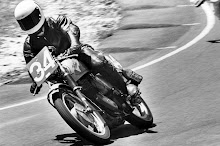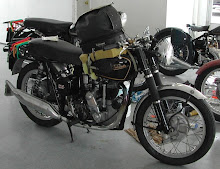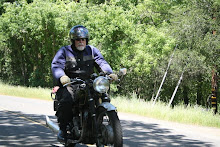The Mk.8 KTT was the first production motorcycle to be fitted with a rear swinging arm and as we call it now the “twin shock” rear suspension setup.
The model was introduced around May 1939, although the Velocette factory racers had them from early 1936.
But let me look at these rear units first…..
Made by Dowty, a
George Dowty was an aircraft engineer, starting his engineering career at Heenan and Froude, well known for their engine test equipment, but during WW1 built aero engines under War Dept. contracts. His apprenticeship with them lasted from 1915-1918. He moved through various companies before joining the design staff at A.V.Roe in 1921 and published scientific papers in aviation journals and in the Institute of Aeronautical Engineers, several were of arresting mechanisms for aircraft for there were early attempts at what we now know as the aircraft carrier to launch and retrieve aircraft from ships.
During the latter half of 1920’s he published more papers on possible designs for aircraft undercarriages and a form of shock absorber strut.
He moved onto to the Gloster Aircraft Company in the design department shortly after and it was from here he made the decision to go out on his own.
He had formed his own company “The Aircraft Components Company” in 1930 while still at Glosters to sub contract out production of some of his designs but due to a misunderstanding in a quotation he made for the supply of six internally sprung wheels for the Kawasaki Company of Japan he was forced to make them himself and so with a small staff the future giant Dowty organisation was born.
It wasn’t until around 1932 that he offered the Dowty Oleo Pneumatic Strut for sale and readers so far are perhaps wondering as to this preamble….
It was early in 1936, barely 4 years after Dowty had started making these struts that Harold Willis and Percy Goodman of Veloce Ltd. made the trip to Cheltenham to speak to George Dowty about the supply of a special oleo leg to be used on the rear suspension of the factory Velocette racers.
Now who actually thought up the idea of this is shrouded in the mists of time, for all participants are dead and I’ve discussed this on numerous occasions with Ivan Rhodes.
The consensus between us seems to be that either Harold Willis, Charles Udall, possibly Phil Irving and others or all in discussion came up the idea of removing the rear fork section of their current rigid frame, welding a form of steering head casting across the rear down tube and fabricating some arms that initially were internally spined and slid onto a splined trunnion shaft ( some accuracy needed here to ensure the axle slots at the end of the forks were dead in line…). The “bearings” were the actual cup and cone steering head races.
Ivan has the one of the first frames made, designated SF2 and the picture below, clearly shows all the above.
Some form of springing and damping mechanism was needed.
As Harold Willis flew his own aircraft a DH60 Moth known by him as “Clattering Kate”, he obviously read the flight magazines, “Flight” and “The Aeroplane” of the day, as well as technical society papers and according to Charles Udall in an interview with Ivan late in Udall’s life , Willis was the one who came up with an idea and visits to the Dowty company in Glostershire, presumably with Percy Goodman, followed.
These units were fitted to the Veloce race team from 1936 and as mentioned offered on the production racer, the mk.8 KTT made by them for sale to the racing public from 1939 to its cessation in 1951.
I corresponded with the Dowty Organisation in the late 1970’s in an effort to unravel the puzzle but regrettably George Dowty, now Sir George after being knighted for his contributions to aviation, had died some 9 months earlier.
His replacement was unsure of this aspect of their early work and offered no help, so the matter rests as it is.
What are these units?
They have no internal spring and rely solely on air as the suspension medium, with oil as the damping medium, which can be adjusted. The units are pumped to 40 psi of air, which isn’t much and I’ve raced with them on my mk.8 KTTs and provided the internal seals are under oil ( which has a tendency to leak out), the units stay up and do work.
But what they would be like after over 200 miles of racing during an IOM TT race I cannot hazard a guess.
These first units illustrated below on the 1936 works bikes were machined from solid material and the external dust covers were leather sleeves.
Those fitted to the 1939 Mk.8 were a production version, but also had leather gaiters for dust protection and the damping adjustment was via a needle valve similar to an Amal carb. pilot jet. With the reintroduction of the mk.8 in 1947, the units were basically identical and Drew Duncan has kindly photographed one dismantled and laid out for inspection. The external dust cover was an aluminium sleeve with fibre blocks top and bottom, but the damping was done with a hollow bolt with two milled grooves of different widths to regulate the oil and effect damping. The bolt had an arrow stamped on the head of the bolt and this allowed the bolt to be rotated through up to just short of 90 degrees to mask off these grooves.
Below are a variety of photos to illustrate, from my archive and whose use is acknowledged to Morton’s Motorcycle Media, S.R. Keig Ltd and others.
Left click on images to enlarge….
Stanley Woods on his 1936 350 DOHC Velocette with rear oleo legs. IOM TT.
Prewar views of the rear Dowty Oleo legs....
David Whitworth, June 1939, IOM TT
Australian Frank Mussett, left and NZer Len Perry on their newly collected Mk.8 KTT racers in May 1939
A brace of Mk.8 KTT's in the Veloce race shop awaiting despatch to new owners, May 1939.
Post-war mk.8 KTT and factory rear oleos...
The post-war rear units dismantled.
 A small device made to the factory instruction for inflating both units to the identical pressure. Difficult as using a normal tyre pressure guage with such a small amount of air in each leg meant that on removing the guage, the invariable loss of air differed in each leg.
A small device made to the factory instruction for inflating both units to the identical pressure. Difficult as using a normal tyre pressure guage with such a small amount of air in each leg meant that on removing the guage, the invariable loss of air differed in each leg.
Initially excess air is pumped into the unit and this device attached.
Careful study of the device show how the knurled screw rotates in and lifts the kilner valve seal open.
Using the carb. type pilot screw, air is slowly released to say 35 to 40 psi, depending on what you were using.
Then the knurled screw is rotated out allowing the kilner valve to seat and the inside of the oleo is at this pressure and when the device is unscrewed off the kilner valve, there is no internal air loss. Cunning.
























3 comments:
av roe also built a motorcycle around the time he was there did he have a hand in that? dave
looking at your great pictures i noticed that mussett and perry have what looks like rubber gaiters on their shocks dave
interesting article, I knew Dowty made some of the best bonded seals about, but I didnt realise they had such a longrunning tie with the motorbike industry! thanks.
Post a Comment